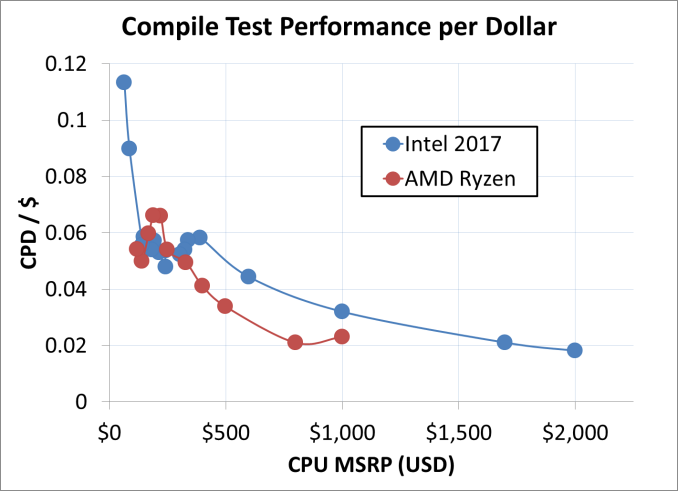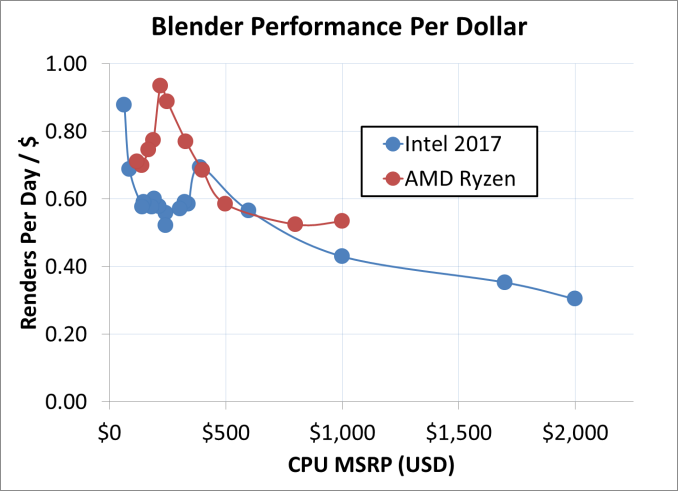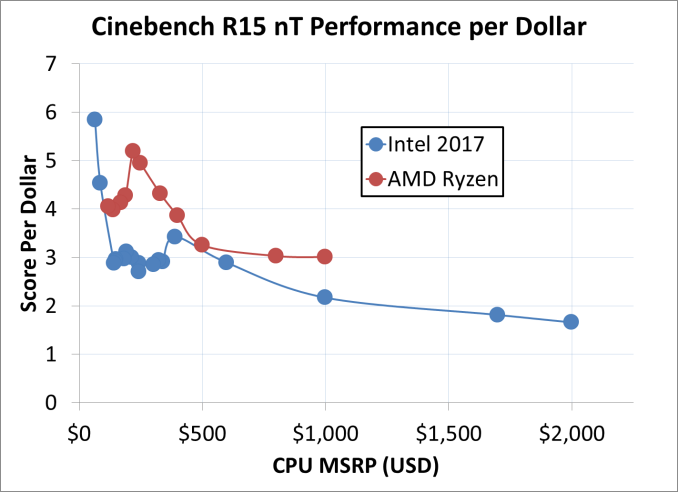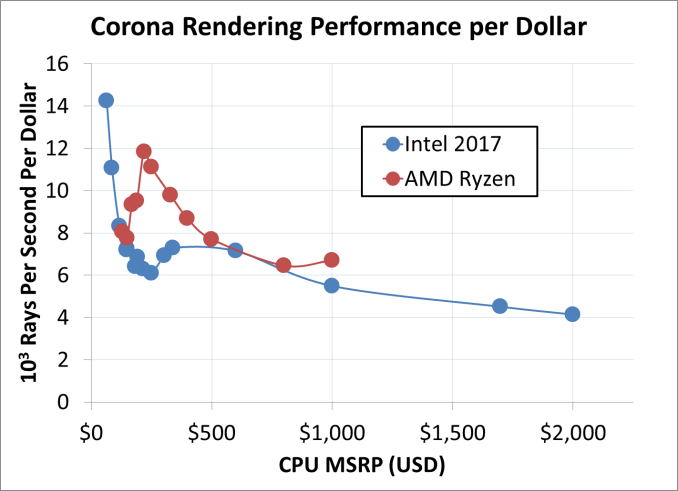The Intel Core i9-7980XE and Core i9-7960X CPU Review Part 1: Workstation
by Ian Cutress on September 25, 2017 3:01 AM ESTAnalyzing Performance Per Dollar
While measuring the performance per watt is an interesting metric, workstation processors are at the top of the stack when it comes to power consumption: the point of these processors (typically) is getting work done fast, and their users don't mind using a bit more power to get there. When it comes to designing a workstation level system for an office, the person who signs off on the project is not going to look at the performance per watt - they are going to look at the performance per dollar. Does this purchase represent the best value for the environment, and is the purchase likely to give us the best return? The following graphs attempt to answer that information, and we've chosen a varied selection including variable threaded loads.
For this analysis, we've taken all of the processors we have tested from what Intel has launched in 2017. This covers all of the consumer level Kaby Lake-S i7 and i5 parts (except T), the high-end desktop Kaby Lake-X processors, and all the high-end Skylake-X desktop parts. This is represented in the graphs in blue under the 'Intel 2017' title. From AMD, we have all eleven AMD Ryzen processors tested, under the red line.
Compile Performance Per Dollar
One of our popular benchmarks is our compile test. This takes a fixed version of Chromium v56, and runs it through the MSVC compiler with linking as per the directions given on by the Chromium developers. A typical test can run from 40 minutes to 3 hours depending on the processor, and taxes the single thread, the multi-thread and the memory performance of the system. We've seen that it does not particularly take kindly to processors with victim caches, such as Skylake-X or AMD Ryzen, with limited scaling on the code workflow. Despite the per-core performance dip from Skylake-S to Skylake-X, the top processor still has the best absolute performance. Converting our data to the number of compiles per day per dollar gives the following graph:
The cheaper end of the graph is surprisingly high, dominated by Intel's dual-core Pentium (with hyperthreading) being offered for super low prices. In the standard 'consumer' price range below $300, the mid-range Ryzen processors have a slight advantage, but, beyond the Ryzen 7 1700, Intel has the performance per dollar advantage all the way out to $2000.
Agisoft Performance Per Dollar
The Agisoft Photoscan software has been a key part of our performance testing for several years, demonstrating a true office workflow: archival purposes of taking 2D photos and converting them into 3D models. This is a computationally interesting algorithm, involving multiple single-threaded and multi-threaded stages.
Due to the single threaded elements of the algorithm, linear scaling is not observed as we ramp up through the core counts. At the mid-range consumer processor pricing, the twelve-thread Ryzen 5 processors sit above the quad-thread Core i5 parts, but beyond $330 or so, as we move into Intel's quad-core offerings and above, the performance per dollar is solely on Intel's side.
Blender Performance Per Dollar
The Blender benchmark has been an interesting debate in the last few months, with the new architectures from Intel and AMD pushing updates into the code for faster rendering. Our test takes a well used Blender release and one of the standard benchmarks (rather than anything vendor specified). Results are given in renders of this benchmark per day per dollar.
Interestingly AMD takes the peak PPD across the full range. At $999, where the competition is expected to be highest, AMD has over a 10% advantage. In the four digit range, even though the PPD of Intel's processors is lower, the absolute performance is still better. For our Blender test, this translates so a few seconds over a 2-3 minute test.
Cinebench R15 nT Performance Per Dollar
Next we move into the pure multithreaded benchmarks, which can be a significant number of workstation workloads. Here Intel might be at a disadvantage, with AMD offering more cores and more threads at each price point - Intel's IPC advantage will have to offset this in order to move ahead.
To lay some background here: AMD has been plugging Cinebench R15 nT benchmark numbers since the launch of Zen, citing better PPD. Intel's rebuttal is that in absolute performance, when you need the absolute best results, their hardware still wins.
Corona Rendering Performance Per Dollar
Ray tracing is another example of light threads taking advantage of more cores, more frequency, higher IPC and accelerated intructions with fast FP throughput. Citing back to Johan's EPYC review again, which showed AMD's good base FP performance, it will be an interesting comparison.
Similar to some of the previous graphs, the best PPD is held at Intel's low end Pentium processors - however these do not give the best overall throughput. In the mainstream price range, the Ryzen 5 1600 and 1600X are suprising peak results. In the $500-$800 range, Intel and AMD are about equal, however at $999 the Threadripper is ahead of the Core i9. Again, at the $1500+ range, Intel offers the better overall throughput, despite the lower PPD.















152 Comments
View All Comments
ddriver - Monday, September 25, 2017 - link
You are living in a world of mainstream TV functional BS.Quantum computing will never replace computers as we know and use them. QC is very good at a very few tasks, which classical computers are notoriously bad at. The same goes vice versa - QC suck for regular computing tasks.
Which is OK, because we already have enough single thread performance. And all the truly demanding tasks that require more performance due to their time staking nature scale very well, often perfectly, with the addition of cores, or even nodes in a cluster mode.
There might be some wiggle room in terms of process and material, but I am not overly optimistic seeing how we are already hitting the limits on silicon and there is no actual progress made on superior alternatives. Are they like gonna wait until they hit the wall to make something happen?
At any rate, in 30 years, we'd be far more concerned with surviving war, drought and starvation than with computing. A problem that "solves itself" ;)
SharpEars - Monday, September 25, 2017 - link
You are absolutely correct regarding quantum computing and it is photonic computing that we should be looking towards.Notmyusualid - Monday, September 25, 2017 - link
@ SharpEarsYes, as alluded to by IEEE. But I've not looked at it in a couple of years or so, and I think they were still struggling with an optical DRAM of sorts.
Gothmoth - Monday, September 25, 2017 - link
and what have they done for the past 6 years?i am glad that i get more cores instead of 5-10% performance per generation.
Krysto - Monday, September 25, 2017 - link
The would if they could. Improvements in IPC have been negligible since Ivy Bridge.kuruk - Monday, September 25, 2017 - link
Can you add Monero(Cryptonight) performance? Since Cryptonight requires at least 2MB of L3 cache per core for best performance, it would be nice to see how these compare to Threadripper.evilpaul666 - Monday, September 25, 2017 - link
I'd really like it if Enthusiast ECC RAM was a thing.I used to always run ECC on Athlons back in the Pentium III/4 days.Now with 32-128x more memory that's running 30x faster it doesn't seem like it would be a bad thing to have...
someonesomewherelse - Saturday, October 14, 2017 - link
It is. Buy AMD.IGTrading - Monday, September 25, 2017 - link
I think we're being to kind on Intel.Despite the article clearly mentioning it in a proper and professional way, the calm tone of the conclusion seem to legitimize and make it acceptable that Intel basically deceives its customers and ships a CPU that consumes almost 16% more power than its stated TDP.
THIS IS UNACCEPTABLE and UNPROFESSIONAL from Intel.
I'm not "shouting" this :) , but I'm trying to underline this fact by putting it in caps.
People could burn their systems if they design workstations and use cooling solutions for 165W TDP.
If AMD would have done anything remotely similar, we would have seen titles like "AMD's CPU can fry eggs / system killer / motherboard breaker" and so on ...
On the other hand, when Intel does this, it is silently, calmly and professionally deemed acceptable.
It is my view that such a thing is not acceptable and these products should be banned from the market UNTIL Intel corrects its documentation or the power consumption.
The i7960X fits perfectly in its TDP of 165W, how come i7980X is allowed to run wild and consume 16% more ?!
This is similar with the way people accepted every crapping design and driver fail from nVIDIA, even DEAD GPUs while complaining about AMD's "bad drivers" that never destroyed a video card like nVIDIA did. See link : https://www.youtube.com/watch?v=dE-YM_3YBm0
This is not cutting Intel "some slack" this is accepting shit, lies and mockery and paing 2000 USD for it.
For 2000$ I expect the CPU to run like a Bentley for life, not like modded Mustang which will blow up if you expect it to work as reliably as a stock model.
whatevs - Monday, September 25, 2017 - link
What a load of ignorance. Intel tdp is *average* power at *base* clocks, uses more power at all core turbo clocks here. Disable turbo if that's too much power for you.